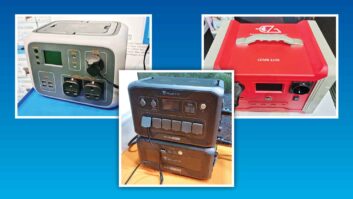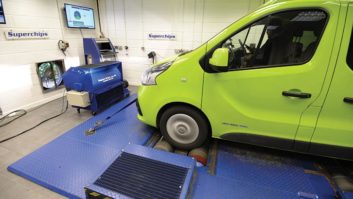Something of a vehicle warranty war broke out back in the early 2000s, when many Korean firms began offering seven-year warranties. Vauxhall went one better in 2010, offering a lifetime warranty – albeit up to 100,000 miles – for the first owner of the vehicle (some vehicles still have this, but sadly it isn’t transferable to the second owner, and the scheme ended in 2015).
A manufacturer-backed warranty is often viewed as the ultimate in vehicle warranties, and you could be forgiven for thinking that with one in place, your ’van is fully protected against any mechanical maladies that might befall it. The trouble is, it’s not that simple.
There are good and bad warranties out there and the devil is in the detail. Motorhome warranties also operate differently to those for cars, and are far more complicated, because they tend to involve several warranties, provided by different firms.
Navigating who is responsible for what is half the battle. So, whether you’re buying a new or used motorhome and regardless of the size of motorhome you’re thinking about, what should you look for?
Understanding motorhome warranties
Consumable items
Manufacturer warranties
Paintwork and corrosion
Used motorhome warranties
Consumer Rights Act 2015
Small Claims Court
Terms and conditions
Invalidating a motorhome warranty
What you need to know about a motorhome warranty
Consumable items
Before we get into the nuts and bolts of motorhome warranties, it’s helpful to understand which things are almost never covered under a warranty. These tend to be the consumable items that even the best motorhomes naturally wear out over time.
The phrase ‘normal wear and tear’ often features in warranty booklet exclusions, but what does it exclude?
Motorhome tyres, brake pads, handbrake shoes, dampers and exhausts are generally considered to be wear and tear items. Buy any used vehicle a few years old and it will always need one or more of these items. Warranty firms know this and will exclude them.

Where things get more complicated is when it comes to items such as clutches. A normal manual gearbox uses a clutch assembly to transit the drive from the engine to the wheels. The clutch assembly is basically two bits of metal that spring together to sandwich a friction disc in the middle. The friction disc wears out over time – just like brake pads – and either becomes too thin (causing the clutch to slip, often denoted by high engine revs in high gears) or simply fall apart and disintegrate, making gear selection difficult.
As the gearbox has to be removed to renew the clutch, the labour costs are going to be high and this can be an expensive job to have done.
Warranty firms often cover items like the flywheel and pressure plate of the clutch assembly (which fail less often), but nearly always exclude the bit that fails the most – the friction disc.

It’s a similar story with the engine itself. On higher-mileage engines, piston ring wear can be an issue.
Symptoms of this problem can be blue smoke on start-up, reduced power and excessive oil consumption.
Again, most warranty providers will cover failure of the piston itself (which rarely fails on a standard diesel engine), but not the piston rings.
So the warranty firms are very deliberate about the items that they are prepared to cover.
Manufacturer warranties
When you’re buying a new motorhome, it will come with several different warranties – on the base vehicle, the habitation conversion and the individual appliances fitted in it.
It’s best to think of your motorhome as being like a house, with different manufacturer warranties on kitchen, washroom and bedroom fittings.
This makes motorhome warranties far more complicated than those of a car, where you will only have one provider to deal with.
A mechanical issue with one of the best vans for a camper conversion will be covered by the vehicle manufacturer warranty (for example, Fiat) and needs to be dealt with by a Fiat Professional dealer.

One important thing to check is who the warranty is with – three-year ’van warranties are often a manufacturer-backed warranty in years one and two, followed by an insurance company backed warranty in year three. This tends to mean you have a reduced level of cover in the third year.
A problem with the habitation equipment should usually be dealt with by your supplying dealership, if it is a new vehicle still under the warranty from the make of motorhome.
Common exclusions to these warranties tend to be wear and tear items, such as seat trim and – the most common of all – hinge, latch or catch failures.

Motorhome habitation warranties are typically around three years long and often include separate water ingress warranties of about six years, which are usually subject to an annual habitation inspection.
Appliances in the vehicle, such as the boiler, cooker, heater or fridge, are subject to the manufacturer of that particular component (for example, Dometic). These items tend to carry 24-month warranties against defects.
Paintwork and corrosion
Rust is much less of an issue than it used to be on commercial vehicles, mainly thanks to advances in paint preparation, galvanized panels and better stonechip protection.
However, if you’ve been thinking is it worth buying an older motorhome, it’s worth considering that it can still be a factor on used vehicles. With all pre-owned motorhomes, check them carefully for rust – especially if they have had any paintwork repairs or damage.
New vehicles often come with warranties against paintwork defects – typically around two or three years – and corrosion (or anti-perforation) warranties, which are usually around 10 years (Fiat’s is eight years).

All of these motorhome warranties tend to be subject to inspection and this can carry an annual fee. Skip an inspection and the warranty is invalid. In my opinion, this can limit their value a little; in some cases it might be cheaper to pay for repairs yourself when they happen, rather than pay a large sum each year for an annual inspection.
What isn’t usually covered is any rust caused by accident damage, or an untreated stonechip causing bubbling under the panel. So you should always treat any stonechips as soon as you spot them (your local bodyshop supply shop is the best place to source touch-up paint and filled aerosols, and can make any paint colour while you wait).
The corrosion warranties can sometimes be worded so that they exclude any rust that has started on the exterior of a panel and then enlarged. Most only cover rust from inside a panel that has then spread outwards to perforate it.
Once the rust has perforated a panel, it is difficult to assess how it originally started, so again, this would potentially be easier for them to dispute a claim over.
Used motorhome warranties
If you buy a used motorhome that is out of manufacturer warranty, a dealer will often sell you a vehicle with a used car warranty. This is partly to cover themselves against unforeseen issues that might arise and partly to avoid falling foul of the Consumer Rights Act 2015 – more about this below.
These warranties vary enormously, from basic versions that cover almost nothing to comprehensive policies. Generally, if the dealer throws it in for free, it’s likely to be a more basic one, while if you have to pay for it yourself, it can be more comprehensive.
But no warranty covers you for every eventuality and most will specifically exclude certain components.
So to assess how good a used vehicle warranty actually is, we suggest you carefully read the warranty booklet and look out for these specific items:
- Clutch friction disc
- Dual mass flywheel
- Piston rings
- Valve guides
- Valve stem oil seals
- Crank main bearings
- Conrod small end bearing
- Conrod big end bearing
- Cambelt and tensioners
- Timing chain and tensioners
- Alternator
- Starter motor
- Battery
- DPF system
- Fuel injectors
- Fuel pump
- Fuel rail
- Exhaust system
- Catalytic converter
- Suspension spring
- Suspension damper
- Suspension bushes
- Engine mounts
All of these are common failure points over time, so the fewer that are excluded, the more worthwhile the warranty.
Consumer Rights Act 2015
The Consumer Rights Act 2015 is a powerful piece of legislation. Under its terms, goods must have three key attributes. They must be:
- Of satisfactory quality (that is, reliable and of a quality consistent with the price and age)
- Fit for purpose (for example, if you want a motorhome for towing, it must be suitable for that)
- As described (that is, if it says it has had no accidents, this must be true)
The Consumer Rights Act applies to the seller of the vehicle. So if you bought it from a motorhome retailer, it applies to them. If you bought it used from a dealer, they are also subject to the Act and your contract is with them.
It is very important to recognise this point. For example, if you buy a used Swift motorhome from a dealership, the dealer is ultimately liable for its condition, not Swift.
The dealer may choose to reclaim money via Swift under warranty (if any is in force), but ultimately your contract lies with the dealer and they are the ones to pursue via the legal route if it comes to that.

Even if you buy a vehicle in a private sale, the Consumer Rights Act applies, although your legal rights are far more limited. Be very careful when buying privately – especially from Facebook Marketplace – because many traders masquerade as private sellers (which is illegal) in an attempt to evade the Consumer Rights Act.
Always try to get a phone number for any vehicle for sale and start the conversation by saying: “I’m ringing up about the vehicle for sale.” If the response is “Which one?”, you are probably dealing with a trader.
Another potentially risky place to buy a vehicle from is a live auction – here your rights tend to be more limited than in a private sale and you’ll need to read through the auction company’s terms and conditions very carefully to see what protection you might have.
Even if the vehicle is stolen, you usually have no comeback with the auction firm, so you really do need to tread very carefully.
Having attended a few motorhome auctions myself, in my personal opinion the quality of vehicles crossing the block isn’t generally very high – this is where models that have problems, crash damage or weird layouts, or are just generally unloved, often end up.
Small Claims Court
Taking a dealer to court may strike fear into you, but there is an easy-to-use online mechanism. No solicitors are needed! The smalls claims court refers to a county court claim, which you can make at gov.uk/make-court-claim-for-money/make-claim.
There will be a fee associated with each claim and this is dependent on the size of the claim. For example, a claim of up to £300 costs £35, claims of £1500.01-£3000 cost £115 and claims of £10,000.01-£200,000 are subject to 5% of the claim amount.
Once you submit a claim, the court will automatically contact the dealer or manufacturer concerned. This can often prompt them to offer you a deal. If they contest the claim and it’s under £10,000, you’ll be asked to attend mediation. This service is free and impartial.
If a verbal agreement between both parties is reached at this point, it will be legally binding and if, for example, the firm refuses to pay out, they can be taken to court for a judgment.
If a firm is being obstinate and you are being reasonable and fair in your demands, it might well be worth attending court.
You’re highly recommended to use a solicitor at this stage, to avoid falling foul of any quirks of the legal system.
Terms and conditions
For some warranties to be valid, the vehicle must be serviced at the service intervals specified in the handbook and must be carried out by a main dealer.
Not all warranties stipulate servicing must be carried out by a main dealer. Some allow you to use a local garage, but stipulate that genuine parts must be fitted and manufacturer-approved fluids must be used. It is extremely important to use the correct grade of oil for servicing work.

The timing of the service is also very important. Service a vehicle a week late, or at too high a mileage, and you risk invalidating your claim. As all service centres seem to be extremely busy at the moment, always ring up to make a booking at least a couple of months before you need it.
It’s also very important to report any faults – ideally via email to leave a paper trail, not just a phone call – promptly within the warranty period.

This is particularly important as you near the expiry date of your warranty (or in the case of the warranty provider changing – for example, at the end of year two, if year three is provided by an insurance company).
The date of the reported issue must be within the period of the warranty. If the fault began during that period, but you only reported it after the warranty had expired, you’ll have to prove the problem existed during the warranty period. This is difficult to do.
You will need to be methodical and highly organised in the way in which you report a warranty issue.
Keep all paperwork, take photos of the problem, and ensure that you email all of the parties concerned and make copies of every single invoice.
Warranty providers do exactly the same thing and vehicle manufacturers employ whole teams of people whose full-time job is to check the validity of customers’ warranty claims.
Invalidating a motorhome warranty
If you have a new vehicle warranty, you usually need to have the motorhome serviced by a main dealer at the correct intervals and mileage. Go past your annual service limit or mileage limit by even a day or a mile and you risk invalidating the warranty.
All fluids used in the vehicle often need to be manufacturer-approved and definitely of the correct grade for the vehicle. This is particularly crucial when it comes to engine oil.
Just using an oil of the same viscosity, as detailed in the manual (for example, 5W 30) isn’t enough. It must also meet the manufacturer’s specification for its detergent packages and additives.
This is often determined by a code (for example, C2, A40) that is detailed in the handbook. Some products list the manufacturers on the oil tub.
Fail to use the correct oil just once and your warranty may be invalid (traces of previous oil grades linger in an engine). Manufacturers do test the oil in the event of a claim.
I would recommend not adding any oil additives to your oil. Equally, do not use any in-tank additives in your fuel tank – stick to pump fuels only (the posh diesel has more additives in it and is worth using on occasion, but nothing else). Many fuel caps now carry a warning against using fuel additives.
After getting your motorhome warranty sorted, you can start thinking about the various motorhome upgrades that could make a real difference to your touring experience.
Future Publishing Limited, the publisher of Practical Motorhome, provides the information in this article in good faith and makes no representation as to its completeness or accuracy. This article is based on information available in March 2025 and is intended as a general overview of common warranty questions. References to specific products are for illustration only and not intended as recommendation. To the fullest extent permitted by law, neither Future nor its employees or agents shall have any liability in connection with the use of this information.
If you enjoyed reading this article, why not get the latest news, reviews and features delivered to your door or inbox every month? Take advantage of our brilliant Practical Motorhome SUBSCRIBERS’ OFFER and SIGN UP TO OUR NEWSLETTER for regular weekly updates on all things motorhome related.



































